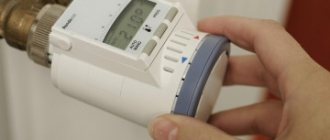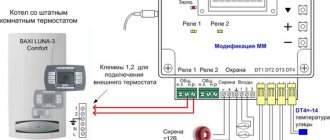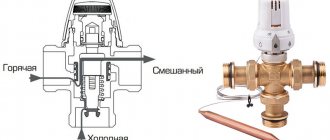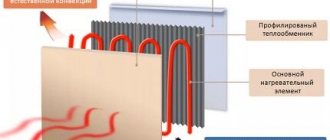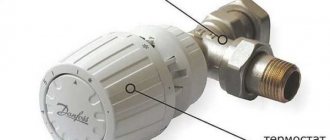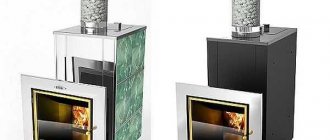A heat meter is a device for recording consumed coolant, which is currently very profitable, as it allows you to save money by paying only for consumed heat, excluding overpayments.
An important point is the correct choice of the type of device depending on the installation location and design features of the heating network, as well as concluding an agreement with a service organization that will monitor the technical condition of the device.
There are many models of heat meters, differing in design and size, but the principle of how a heating meter works remains the same as with a simple device that measures the temperature and water flow at the inlet and outlet of the pipeline of a heating supply facility. Differences appear only in engineering approaches to solving this issue.
Principle of operation
The operation of the heat meter is based on the principle of calculating the amount of heat using data taken from a coolant flow sensor and a pair of temperature sensors. The amount of water passing through the heating system is measured, as well as the temperature difference at the inlet and outlet.
The amount of heat is calculated by the product of the flow rate of water passing through the heating system and the difference in temperature of the incoming and outgoing coolant, which is expressed by the formula
Q = G * (t1-t2) , gCal/h, in which:
- G – mass flow of water, t/h;
- T1,2 – temperature indicators of water at the inlet and outlet of the system, °C.
All data from the sensors is sent to the computer, which, after processing it, determines the value of heat consumption and records the result in the archive. The value of consumed heat is displayed on the device display and can be taken at any time.
What affects the accuracy of the heat meter
Techem compact V
A heat meter, like any precision device, when measuring consumed heat has a certain total error, which is the sum of the errors of the temperature sensors, flow meter and calculator. In apartment accounting, devices are used that have an acceptable error of 6-10%. The actual error may exceed the basic one, depending on the technical characteristics of the component elements.
The increase in the indicator is determined by the following factors:
- The amplitude of the incoming and outgoing coolant temperatures, which is less than 30°C .
- Violations during installation in accordance with the manufacturer's requirements (if installed by an unlicensed organization, the manufacturer will withdraw its warranty obligations).
- Poor quality of pipes, hard water used in the coolant, and the presence of mechanical impurities in it.
- When the coolant flow rate is below the minimum value indicated in the technical specifications of the device.
How is heat consumed measured?
It is customary to calculate the tariff for consumed heat in gigacalories. The unit of measurement is non-systemic, and has traditionally been used since the existence of the USSR. Devices manufactured in Europe calculate heat consumption in GigaJoules (SI system), or the generally accepted international non-systemic unit kWh (kWh) .
Differences in measurement systems among employees of heat supply organizations do not cause any particular difficulties in how to calculate heating charges, since some units are easily converted to others using a certain coefficient.
Installation procedure
Installation of a common house heat energy meter is a sequential and complex process. First of all, a meeting of the owners of the apartment building is held. This is a mandatory condition, which, moreover, is the basis for further installation. In most cases, the initiator of such a meeting is the management company. If the house is managed by a homeowners association, residential complex or housing cooperative, the meeting is held at the request of the owners based on 10% of their signatures.
Next steps:
- Issuance by the heat supply organization of technical specifications for the installation of a common house meter.
- Development of an installation project and preparation of an estimate by the design organization, taking into account the selected device model and installation location.
- Coordination of the prepared project with the resource supply company, which previously issued the technical specifications.
- Purchase of a heat energy meter approved by the project, which must have a verification stamp.
- Installation work and commissioning of the common house meter, after which the whole process comes to its logical conclusion.
So now you know who should pay for installation
electricity meter, and who should do this anyway. This knowledge will definitely raise your level of household literacy. As for the meters themselves, be sure to buy them from a reputable place. For example, RosSchet provides a wide range of relatively inexpensive metering devices for household needs.
Types of heat meters
All heating meters available for purchase are divided into the following types:
- Tachometer or mechanical
Measures the amount of coolant passed through a cross-section of a pipe using a rotating part. The active part of the apparatus can be screw, turbine or in the form of an impeller. The devices are affordable and easy to use. The weakness of such devices is their sensitivity to contamination and the deposition of dirt, rust, and water hammer inside the mechanism. For this purpose, the design includes a special magnetic mesh filter. Also, the devices are not capable of storing data collected per day.
- Ultrasonic
More often used as a general meter for an apartment building. Has varieties:
- frequency,
- temporal,
- Doppler,
- correlational. It works on the principle of generating ultrasound passing through water.
The signal is generated by the transmitter and picked up by the receiver after passing through the water column. Guarantees high measurement accuracy only if the coolant is sufficiently clean.
- Electromagnetic
It is distinguished by high accuracy of readings and cost. The operation of the device is based on the principle of passing a magnetic field through the coolant flow, which reacts to its condition. The device requires periodic maintenance and cleaning. Consists of a primary converter, an electronic unit and temperature sensors.
- Vortex
It works on the principle of measuring the number and speed of vortices. It is not sensitive to blockages, but reacts to the appearance of air in the system. The device is installed in a horizontal position between two pipes.
Who is responsible for the communal heat meter in an apartment building?
We will consider the question of who should install a common house meter in an apartment building later, and now we will find out who undertakes to change, repair and otherwise maintain the meter. The answer is simple - the meter is common property, and accordingly, responsibility for its maintenance and further operation lies with the management organization on whose balance sheet the house is located. The same applies to repairs and verification.
You must understand that the management organization is not directly involved in the installation or maintenance of meters. Its task is to allocate finances and order the services of professionals working in specialized companies.
ORDER A SERVICE FROM ACCREDITED COMPANIES
How to convey testimony correctly
An apartment heat meter is functionally much simpler than a modern mobile phone, but users periodically have misunderstandings about the process of taking and sending display readings.
To prevent such situations, before starting the procedure for taking and transmitting readings, it is recommended to carefully study its passport, which provides answers to most questions related to the characteristics and maintenance of the device.
Depending on the design features of the device, data is collected in the following ways:
- From the liquid crystal display by visually capturing readings from various menu sections, which are switched by a button.
- ORTO transmitter , which is included in the basic package of European devices. The method allows you to display and print extended information about the operation of the device on a PC.
- The M-Bus module is included in the delivery of individual meters in order to connect the device to the centralized data collection network of heat supply organizations. Thus, a group of devices is combined into a low-current network using a twisted pair cable and connected to a hub, which periodically polls them. Afterwards, a report is generated and delivered to the heat supply organization, or displayed on a computer display.
- The radio module included in the delivery of some meters transmits data wirelessly over a distance of several hundred meters. When the receiver comes within range of the signal, the readings are recorded and delivered to the heat supply organization. Thus, the receiver is sometimes attached to a garbage truck, which, as it follows a route, collects data from nearby meters.
Archiving of readings
All electronic heat meters store in the archive data on accumulated indicators of thermal energy consumption, operating and idle time, coolant temperature in the forward and return pipelines, total operating time and error codes.
As standard, the device is configured for various archiving modes:
- hourly;
- daily;
- monthly;
- annual.
Some of the data, such as total operating time and error codes, can only be read using a PC and special software installed on it.
Heat meters for heating in an apartment - how to choose and install correctly?
To avoid problems with paying receipts, it is necessary to submit water meter readings in a timely manner; how to do this correctly, read on.
Calculation of heat from underfloor heating, detailed article -
Transfer of readings via the Internet
One of the most convenient ways to transmit readings of consumed thermal energy to institutions for its accounting is transmission via the Internet. Its convenience and practicality lies in the ability to independently control payments and debts, as well as track heat consumption at different periods without standing in queues and spending a small amount of time.
To do this, you must have a personal computer connected to the network and the address of the website of the controlling organization, as well as the login and password of your personal account, after logging into which a form for entering readings will open. To prevent disagreements from arising in the event of a possible failure or malfunction on the site, it is advisable to take “screenshots” of the screen after entering information.
How much does a communal heating meter cost?
The answer to the question of how much a common house heat meter costs,
may well shock many city residents and more. Many believe that such a meter is no different from an apartment meter, and accordingly, it should cost either the same or slightly more. However, the cost of a general metering device is usually orders of magnitude higher than that of an apartment meter.
The average price of a communal heat energy meter is about 60 thousand rubles. The figure is very approximate, since the cost depends on several factors, including the specific model and manufacturer. In any case, saving on its purchase is not recommended. This is fraught not only with a high error, and with it an increased payment for energy resources, but also with the occurrence of accidents. This is practically impossible if a good device is installed.
It is noteworthy that residents have several ways to pay for meter installation. First of all, this is a one-time payment if the entire amount is available. Only this option is available to legal entities ordering the installation of a meter. Installment plans for up to 60 months are also available, with the amount repaid in equal monthly installments. There is also a third option - repaying the amount from the capital repair fund. This is possible if the installation of a common house meter is included in the list of works as part of the overhaul.
How much does it cost to install or replace a common house heat meter?
You must understand that the price of the heat meter itself is only a small part of the amount that needs to be spent on turnkey installation. The full price includes the following costs:
- development and further approval of the project;
- purchase of a heat meter, sensors and flow meters;
- purchase of auxiliary materials for installation;
- direct installation of a common house appliance;
- commissioning and commissioning.
In total, taking into account all the points listed above, the complete installation of a common building coolant meter can range from 180 to 250 thousand rubles. Here again, everything depends on the specific house. In some cases, it takes even more to develop and implement a project.
Who installs communal heat meters?
According to Federal Law No. 261-FZ of November 23, 2009 “On energy saving and increasing energy efficiency, and on introducing amendments to certain legislative acts of the Russian Federation,” all consumed energy resources must be accounted for. This is precisely why communal metering devices are installed in apartment buildings. But what if the apartment building still doesn't have a meter? We know who exactly is responsible and must install the communal heating meter
.
In accordance with the Federal Law mentioned above, the responsibility for installing a metering device for an apartment building lies on the shoulders of the apartment owners. According to the government decree, residents must coordinate their efforts and jointly select a company that will sell the equipment and a contractor who will install the communal meter.
On the other hand, from July 1, 2012 onwards, there is no thermal energy meter in an apartment building; the resource supply organization is obliged to take responsibility for its installation. She must also organize the design and installation work.
Individual heat meters
Installation of an individual heat meter is not necessary. It is installed at the request of the apartment owner, as stated in the Decree of the Government of the Russian Federation dated 05/06/11 No. 354 (clause 3, article 33, section V).
According to the Order of the Ministry of Regional Development dated December 29, 2011 No. 627, individual meters are prohibited from being installed in apartments with vertical wiring.
In addition, in order for the calculations for heating to take into account the readings of apartment meters, they must be installed in each residential and non-residential premises of the apartment building along with a general heat energy meter.
More information about the types of individual heat meters and their purpose is contained in the material “Heat meters for heating in an apartment.”
Maintenance of common house heat metering devices
Maintenance of the meter involves maintaining it in working condition. This is achieved as a result of preventive work, such as:
- inspection and elimination of causes affecting wear and breakdown of the control and measuring unit;
- checking the operation of additional equipment;
- operational maintenance and control of metrological accuracy of measurements of the metering device;
- weekly readings for analysis and development of recommendations for maintaining the required temperature.
If a malfunction is detected during the inspection, the device is dismantled, the damage is repaired and reinstalled.
To get a complete picture of maintaining the ODPU in working condition, find out how the MKD heating system is maintained.
What influences the price range?
There are two decisive factors: manufacturer and type of equipment . Everything is clear with the manufacturer - the cost of the product is directly dependent on the technologies used by the plant. But the type of heat meters directly affects the performance characteristics, and therefore the cost of the product.
The equipment will differ in design features and data reading method . These differences directly affect the ability to install the device on a specific high-rise building.
Affects pricing and service life. Devices that will last from 2 to 4 years less, but the savings, in this case, are questionable. The design, installation and commissioning of the device are not free pleasures, so paying for them every 3-4 years is impractical. Considering that the average payback period for individual devices is at least three years, their purchase becomes economically unprofitable.
Advantages and disadvantages
common house meter
When justifying the need to install ODPU, the Criminal Code usually gives the following arguments:
- payment for actually consumed heat energy. The presence of a meter allows you to accurately monitor heat consumption and reduce heat energy costs by up to 30%;
- recording leaks in the heating system in order to prevent overpayments for water losses from the central pipeline to the house;
- increasing responsibility for the common territory. By paying for losses from their own pockets, residents of the house are more attentive to the condition of the common property.
Along with the advantages, a heat meter for an apartment building also has disadvantages, which primarily relate to the financial burden on the owners of apartments in multi-apartment buildings. All costs associated with installation and repair of the meter are borne by the residents. The fewer apartments in the building, the higher the payments.
